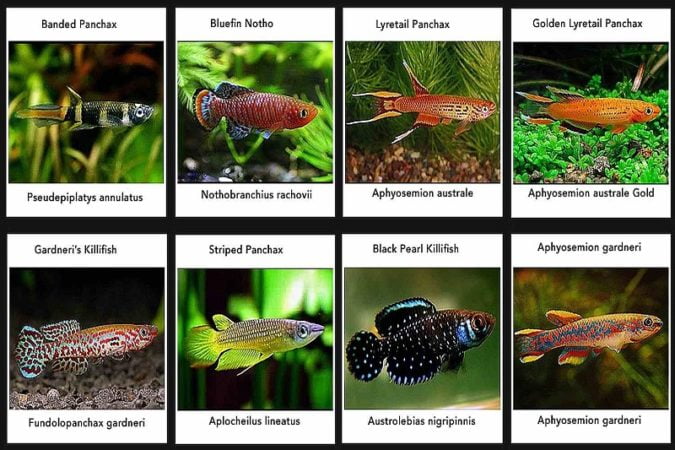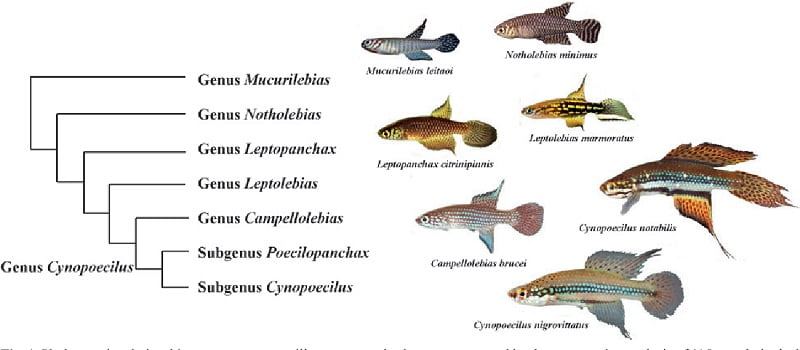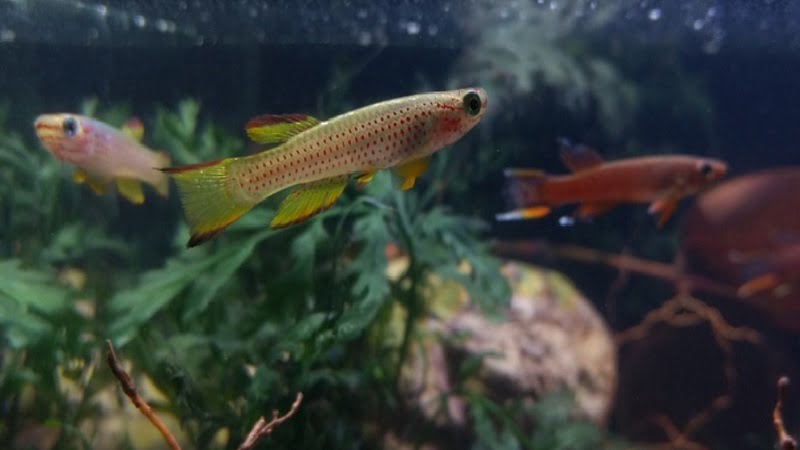When searching for information about the killifish you are interested in, you may find it difficult to pronounce or understand that killifish scientific name. This article may help you know how to understand a scientific name of a killifish species.
General Information About Killifish & Their Scientific Name
- The killifish is also considered egg-laying topminnow, a species included in Cyprinodontiformes, a ray-fined fish order.
- The included killifish families are Aplocheilidae, Cyprinodontidae, Fundulidae, Profundulidae, Valenciidae, and Rivulidae. Particularly, the Rivulidae is the biggest killifish family with more than 320 species.
- Their habitats include brackish, salty, and freshwater, as well as some desert hot springs.
- Typically, killifish can reach a maximum size of about 6 inches (15 cm). Several can grow to just a few centimeters (7 cm).
- These creators are surface feeders that eat either plants or animals.
- The name “killifish” may have a root from the Dutch; ‘kil’ indicates the small stream.
- “Killifish” is sometimes used to indicate the Cyprinodontidae in fish taxonomy, however, a few species of the Cyprinodontidae family possess their common name, including the pupfish and the mummichog.
Understand Killifish Scientific Name
Benefits of using killifish scientific name
The killifish scientific name seems not attractive but knowing their full scientific name can help collect the killifish information more easily and comprehensively, since utilizing the scientific name of specific killifish can provide you a high probability to attain worldwide information sources. Searching with killifish scientific names, you can avoid being confused with a variety of their common names.
Moreover, the scientific name itself gives you a sense of the killifish. In fact, the scientific name of the fish is based on the binomial nomenclature (two-term naming system), featured in taxonomy. Specifically, the name of the living creatures can be given by composing two parts that use Latin grammatical forms. Thus, the “scientific name” is also called the “binominal name” or informally “Latin name”. The terms in the name of the creatures can come from other languages such as Greek and Dutch.
For instance, according to the information above, for instance, the ‘kil’ root in the word ‘killifish’ means ‘small stream’, which implies the habitat of fish. Actually, the most killifish species can be found in shallow water and small streams. Another example is the scientific name of the northern plains killifish, Fundulus kansae. The term “Fundulus” comes from the Latin word ‘fundus’, which means ‘bottom’, to indicate ‘the habitat’. Meanwhile, the word ‘kansae’ implies the type locality.

Confusion caused by common names
There are a variety of common names for Killifish species, so other aquarists may find it difficult to understand what you are referring to if you use a local name or a term that is commonly used in your country. Besides, just a small percentage of the Killifish enthusiasts in the world can identify and distinguish the killifish type if the common names are used. This means it may be difficult to sell, purchase, or obtain advice about specific species. Therefore, by using the killifish scientific name, you can reach a broader audience.
In addition, common names can be shared by several different fish species, which makes it even more difficult to use them. In other words, it is possible to use the name “YYY Killifish” for species A, B, and C at the same time. This can naturally cause confusion and can also result in serious misunderstandings. By using the killifish scientific name, it is easy and apparent to recognize which species you are referring to.
Understanding the hierarchy and relationship
Understanding how to interpret a scientific name can give you essential and useful information. A scientific name usually consists of two parts, one showing the genus and the other giving you an idea of the species’ identification within the genus.
Let’s look at the scientific name Aphyosemion cinnamomeum of the Cinnanmon Killifish, a stunning African species that is kept by many Killifish aficionados. The first part of the name, “Aphyosemion”, shows the genus of the killifish which is genus Aphyosemion. Meanwhile, the second part, “cinnamomeum”, helps you differentiate this species from the other species in the same genus, such as Aphyosemion australe (Lyretail killifish) and Aphyosemion filamentosum (Plumed lyretail). The name meaning of this “Aphyosemion cinnamomeum” name is “Cinnamon coloration of the body”.
There are close relationships between species of killifish belonging to the same genus. For aquarists, knowing this is valuable, since closely related species tend to be similar in anatomy, as well as in requirements and behavior. For example, you have got a new killifish but cannot find any information about how to get their breeding. In this case, you can search for this information of the same genus, and then, you can do experiments based on these findings. It may not get right every time, but your chances could increase significantly. Still, the species in a genus have considerable natural differences, and these can be used for classification.
Besides, when knowing the killifish scientific name, you can explore the relationship between the species and other living creatures in the world.

Let’s take a look at another killifish scientific name: Nothobranchius rachovii, which is commonly known as “bluefin notho” – an annual killifish species.
‘Nothobranchius’ is the genus of the fish, which is derived from the two Greek words: “nothos” = false, spurious, and “bránchia” = gill. The second word of the name, ‘rachovii’, is named in honor of Arthur Rachow, which can be used to distinguish it from the other species within the genus.
Nothobranchius rachovii has a taxonomy, or scientific classification, as follows.
- Kingdom: Animalia – animals
- Subkingdom: Bilateria
- Infrakingdom: Deuterostomia
- Phylum: Chordata – chordates
- Subphylum: Vertebrata – vertebrates
- Superclass: Actinopterygii – ray-finned fishes
- Class: Teleostei
- Superorder: Acanthopterygii
- Order: Cyprinodontiformes – includes killifishes and live-bearers
- Suborder: Aplocheiloidei – aplocheiloids
- Family: Aplocheilidae – Asian killifishes or Asian rivulines
- Subfamily: Aplocheilinae – Old World rivulines
- Genus: Nothobranchius
- Species: Nothobranchius rachovii – bluefin notho
Other elements of killifish names
Apart from the two-part name, many killifish species have their scientific names assigned one or a few additional words and a number. As a result, the killifish scientific name can be quite long and more complicated, than other fish’s names.
When visiting the killifish auction sites, you can come across the name like “Nothobranchius rachovii Beira 98”. As demonstrated above, we have already known what Nothobranchius rachovii indicates, yet there is no hint about “Beira 98”. Though “Beira 98” may give a cryptic sense, it is just a collection code. Specifically, the Beira 98 indicates the location where this species was acquired; it is near the African village named Beira in the year 1998.
If a fish’s ancestry cannot be determined, it is simply referred to as an “Aquarium Strain”. Consequently, Nothobranchius rachovii (Aquarium Strain) is a fish that could have come from anywhere. Thus, the result of breeding your Nothobranchius rachovii Beira 98 with a non-Beira-98 Nothobranchius rachovii will be a Nothobranchius rachovii (Aquarium Strain).
Is it always easy to understand a killifish scientific name?
The answer to this question is unfortunately no. Occasionally, a fish species will be known by more than one scientific name, owing to the different descriptions from different explorers. For example, in 1915, Explorer Anderson saw a killifish in an African puddle, described it, and named it Nothobranchius andersonius. Another explorer travels to the same puddle in 1920, finds the same species, describes it, and names it Nothobranchius victorii after his wife Victoria. As you can see, these two names indicate a single killifish.
Scientific names are also problematic as the taxonomy (the way species are classified) is continually changing. In some cases, DNA tests may reveal that a fish thought to be a Nothobranchius is actually more closely related to a Killifish originating from another African genus. When the fish is transferred to the correct genera, its scientific name will be changed. However, the old name can still remain among aquarists for years until they get a significant announcement about the taxonomic change.
Owing to these reasons, in the posts about killifish, it is common to include the common name, the current scientific name, and synonyms as well. For example:
- Scientific name: Nothobranchius victorii
- Synonyms: Adiniops rachovii
- Common name: Bluefin notho
Video: Killifishes And Their Scientific Names
FAQs
ARE KILLIFISH GUPPIES?
Killifish and guppies are not the same. Actually, they are actually quite different breeds that have more significant differences.
WHAT IS THE SCIENTIFIC NAME FOR MUMMICHOG?
Mummichog killifish scientific name is Fundulus heteroclitus. They are a small killifish species that can be found along the Atlantic coast of North America.
Are killifish minnows?
their heads behind the eyes, and small distinctively shaped, upturned mouths. Also, their dorsal fin is soft, and the tail is square or rounded.
Conclusion
Understanding the scientific name of a killifish species can give you great insights into these fish, such as their family, genus, and connection with other animal species. Due to the taxonomy that is continuously changing, it may get complicated and confusing to recognize a specific killifish scientific name. I hope that this article provides sufficient information to help you know how to examine and understand the scientific name of your killifish.
References:
https://www.fishbase.se/summary/9725
https://www.fishbase.de/summary/9868
https://en.wikipedia.org/wiki/Killifish
https://aka.org/!area_Affiliates/wak/Ref_Library/Fundulopanchax/Fp.cinnamomeus.htm
https://www.itis.gov/servlet/SingleRpt/SingleRpt?search_topic=TSN&search_value=646907#null
https://www.semanticscholar.org/paper/Comparative-morphology-and-classification-of-South-Costa/8cd96e90315318b0f3d586d38eb690df5f48b57d

Annette M. Chaney is an experienced marine biologist with over 20 years of experience as an aquarist and fishkeeper. She started her first aquarium at a young age, filling it with frogs and goldfish obtained from the ten-cent pet store.
Annette grew up caring for and breeding African Cichlids, which led to a hobby in high school that doubled as a profitable means. Attending Reed College gave her time to solidify herself as an accomplished aquarium caretaker with an eye for sales. After that, from 2009 – 2013, she studied at Roger Williams University – one of the most prestigious universities for Aquaculture and Aquarium in USA. She is the founder of AquariumCircle since 2010.
